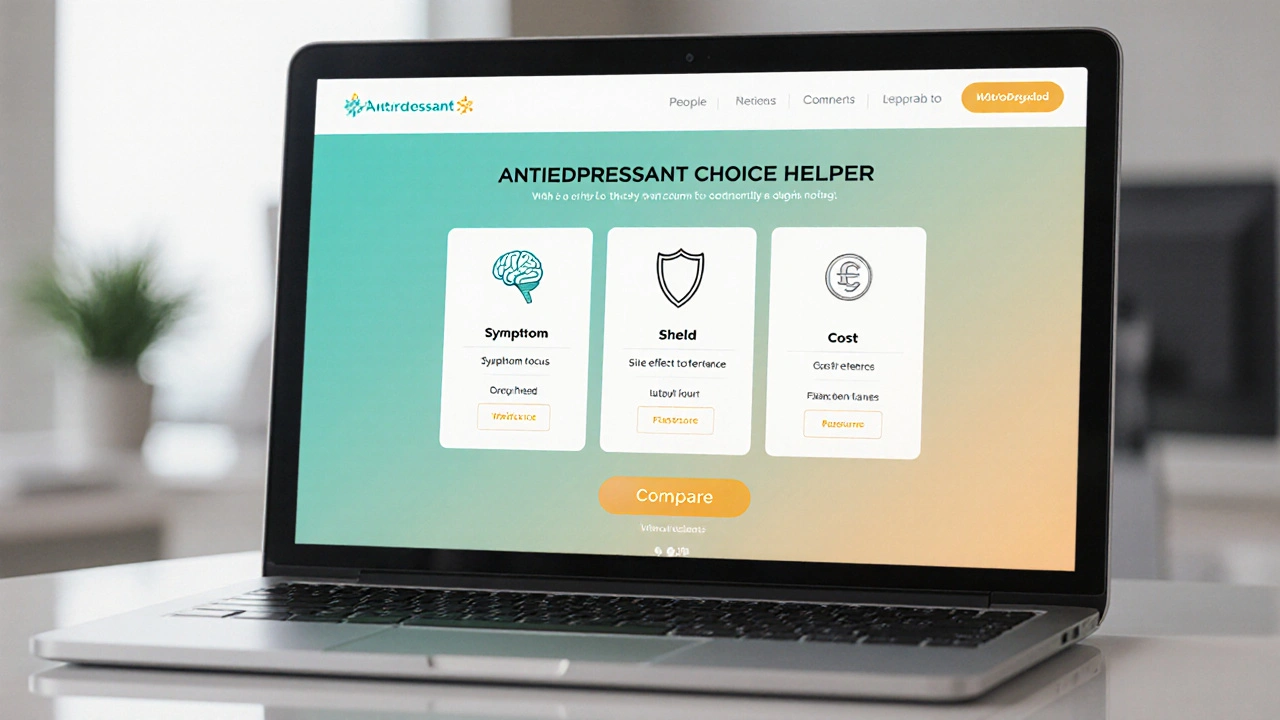Antidepressant Choice Helper
Recommended Antidepressants
Key Takeaways
- Flunil (fluoxetine) is a long‑acting SSRI with a 2‑day half‑life, making it good for patients who miss occasional doses.
- Sertraline and escitalopram tend to work faster but may cause more sexual side effects.
- Venlafaxine and duloxetine are SNRIs; they help both depression and lingering pain but can raise blood pressure.
- Bupropion is a non‑SSRI option that avoids sexual dysfunction but isn’t ideal for anxiety‑dominant cases.
- Choosing the right drug depends on efficacy, side‑effect profile, drug interactions, cost, and personal health history.
What is Flunil (Fluoxetine)?
When you see the name Flunil is the brand name for fluoxetine, a selective serotonin reuptake inhibitor (SSRI) approved by the FDA for major depressive disorder, obsessive‑compulsive disorder, panic disorder, and bulimia nervosa. It was first launched in the late 1980s and quickly became one of the most prescribed antidepressants worldwide.
How Fluoxetine Works
Fluoxetine blocks the serotonin transporter (SERT), increasing serotonin levels in the synaptic cleft. This boost improves mood, anxiety regulation, and appetite control. Its long half‑life (4‑6 days for the parent drug, up to 2 weeks for the active metabolite norfluoxetine) means steady blood levels with once‑daily dosing and a smoother taper when stopping.
Key pharmacokinetic attributes:
- Typical starting dose: 20mg daily, can be titrated up to 80mg.
- Metabolized primarily by CYP2D6 and CYP2C19.
- Low risk of severe withdrawal compared with shorter‑acting SSRIs.
Head‑to‑Head Comparison with Popular Alternatives
| Attribute | Flunil (Fluoxetine) | Sertraline | Escitalopram | Venlafaxine | Duloxetine | Bupropion |
|---|---|---|---|---|---|---|
| Class | SSRI | SSRI | SSRI | SNRI | SNRI | Norepinephrine‑dopamine reuptake inhibitor (NDRI) |
| Half‑life | 4‑6days (parent) / 2weeks (metabolite) | ~26hours | ~27hours | ~5hours | ~12hours | ~21hours |
| Typical dose range | 20‑80mg daily | 50‑200mg daily | 10‑20mg daily | 37.5‑225mg daily (divided) | 30‑120mg daily | 150‑450mg daily (extended‑release) |
| Onset of therapeutic effect | 2‑4weeks | 1‑2weeks | 1‑2weeks | 2‑4weeks | 2‑4weeks | 1‑2weeks |
| Common side effects | Nausea, insomnia, sexual dysfunction | Diarrhea, sexual dysfunction, dizziness | Sexual dysfunction, nausea, fatigue | Increased blood pressure, insomnia, dry mouth | Dry mouth, constipation, sweating | Insomnia, dry mouth, anxiety |
| Weight impact | Weight neutral to slight loss | Weight neutral | Weight neutral | Potential weight gain | Potential weight gain | Weight loss |
| Cost (UK NHS average) | £0.12 per tablet | £0.13 per tablet | £0.14 per tablet | £0.16 per tablet | £0.18 per tablet | £0.15 per tablet |
| Withdrawal risk | Low - taper optional | Moderate - taper needed | Moderate - taper needed | High - taper mandatory | High - taper mandatory | Low‑moderate - taper advisable |

Deep Dive into Each Alternative
Sertraline
Sertraline is an SSRI known for its strong evidence base in depression, PTSD, and social anxiety. It reaches steady state faster than fluoxetine, which many patients like for quicker mood lift, but the shorter half‑life makes missed doses feel sharper.
Escitalopram
Escitalopram is the S‑enantiomer of citalopram, offering higher potency with fewer dose‑related side effects. It’s often the first‑line pick for patients worried about drug‑drug interactions because it has limited CYP450 inhibition.
Venlafaxine
Venlafaxine belongs to the SNRI class; it blocks both serotonin and norepinephrine reuptake, which helps patients with residual fatigue or chronic pain. The trade‑off is a dose‑dependent rise in blood pressure, so regular monitoring is a must.
Duloxetine
Duloxetine is another SNRI, marketed for depression as well as diabetic neuropathy and musculoskeletal pain. Like venlafaxine, it can cause hypertension, but its twice‑daily dosing may suit people who prefer a morning‑evening split.
Bupropion
Bupropion works by inhibiting norepinephrine‑dopamine reuptake, making it a go‑to for patients who experience sexual dysfunction on SSRIs. It’s also the only antidepressant with proven smoking‑cessation benefits, yet it can aggravate anxiety and carries a modest seizure risk at high doses.
How to Choose the Right Antidepressant
Choosing a medication isn’t a one‑size‑fits‑all decision. Below are the main criteria you should weigh against your personal health profile.
- Efficacy for your primary symptoms. If anxiety dominates, an SSRI with strong anxiolytic data (like fluoxetine or sertraline) is a safe bet. If pain is a big factor, an SNRI may be more helpful.
- Side‑effect tolerance. Sexual dysfunction, weight changes, and insomnia affect adherence. For example, bupropion avoids sexual side effects but may increase insomnia.
- Drug interactions. Check the CYP450 pathway. Fluoxetine is a potent CYP2D6 inhibitor, which can raise levels of drugs such as tricyclic antidepressants or certain antipsychotics.
- Pharmacokinetics. Long half‑life (fluoxetine) reduces withdrawal risk, while a short half‑life (sertraline) may be preferred when rapid dose adjustments are needed.
- Cost and insurance coverage. In the UK, most of these agents are NHS‑prescribed generic equivalents, but brand‑name pricing can vary for private patients.
- Medical comorbidities. Hypertension steers you away from high‑dose venlafaxine; a history of seizures suggests caution with bupropion.
Discuss these points openly with your prescriber. A trial period of 4‑6weeks is typical; if you notice no improvement or intolerable side effects, a switch is reasonable.
Practical Tips for Starting or Switching Antidepressants
- Take the first dose in the morning to gauge any activating effects.
- Track mood, sleep, appetite, and side effects in a simple journal for at least two weeks.
- If moving from a short‑acting SSRI to fluoxetine, no washout is needed because fluoxetine’s long half‑life covers the gap.
- When switching to an SNRI, schedule a blood pressure check after two weeks of the new dose.
- Never stop abruptly without a taper plan-especially with fluoxetine, which can cause lingering serotonin‑related symptoms if stopped too fast.
Frequently Asked Questions
Can I take fluoxetine with other psychiatric meds?
Fluoxetine’s strong CYP2D6 inhibition means it can raise blood levels of certain antipsychotics (e.g., risperidone) and tricyclic antidepressants. Always ask your doctor to review the full medication list before adding fluoxetine.
Is fluoxetine safe during pregnancy?
Current guidelines consider fluoxetine a Category C drug: potential risk exists, but untreated depression also harms mother and baby. Your clinician will weigh risks and may prefer a different SSRI with more pregnancy data, such as sertraline.
Why does fluoxetine sometimes cause insomnia?
By increasing serotonin, fluoxetine can boost daytime alertness. Taking the dose early in the morning and limiting caffeine helps. If insomnia persists, a low‑dose evening melatonin or a switch to a more sedating SSRI may be advised.
What’s the biggest advantage of fluoxetine over sertraline?
Fluoxetine’s long half‑life reduces withdrawal symptoms and makes missed doses less disruptive. This can be a lifesaver for people with irregular schedules.
Can I switch from fluoxetine to bupropion without a washout?
Because fluoxetine stays in the system for weeks, a direct switch can cause excess serotonergic activity. Doctors usually recommend a 1‑2‑week washout or a gradual cross‑taper.
Next Steps
If you’re currently on fluoxetine and feel side effects outweigh benefits, schedule a review with your GP or psychiatrist. Bring a list of all medications, note any new symptoms, and discuss which alternative aligns best with your lifestyle and health conditions. Remember, the right antidepressant can make a huge difference in daily functioning-don’t settle for a drug that leaves you stuck.





Dhakad rahul
October 4, 2025 AT 18:11Behold the saga of serotonin, where fluoxetine reigns supreme with a half‑life that could outlast most human commitments 😤. Its long‑acting nature turns missed doses into mere blips on the radar, sparing you the dramatic withdrawal crises that plague short‑lived SSRIs. In the grand tapestry of antidepressants, this drug stands as the indomitable titan of Indian resilience, proving that even our pharmacology can match the vigor of our nation.
William Dizon
October 15, 2025 AT 15:31Hey folks, just a quick heads‑up: if you’re switching from a short‑acting SSRI to fluoxetine, you don’t need a wash‑out period because the long half‑life covers the gap. Keep an eye on any activation symptoms early in the morning and consider a low‑dose melatonin if insomnia becomes an issue. Also, remember to check for drug‑drug interactions, especially with meds metabolized by CYP2D6.
Jenae Bauer
October 26, 2025 AT 12:51The pharma giants hide the real story behind these glossy tables, and most of us never see the hidden agenda. They cherry‑pick data that makes fluoxetine look like a miracle while downplaying the subtle hormonal shifts that could be influencing our very thoughts. It’s a lazy tick‑box exercise that pretends to be scientific, but the truth remains veiled.
vijay sainath
November 6, 2025 AT 10:11Yo, I’m not buying the whole conspiracy vibe, but you’ve got a point about data cherry‑picking. Still, we can’t ignore that fluoxetine’s CYP2D6 inhibition can raise levels of other prescriptions, which is a legit concern. Just saying, stay sharp and read the fine print.
Daisy canales
November 17, 2025 AT 07:31Wow, because we all needed another spreadsheet of side effects.
keyul prajapati
November 28, 2025 AT 04:51When evaluating antidepressants, a systematic approach that incorporates pharmacokinetics, side‑effect profiles, and patient‑specific factors yields the most reliable outcomes. Fluoxetine’s extended half‑life of four to six days, coupled with an active metabolite persisting up to two weeks, differentiates it from agents such as sertraline or escitalopram, whose half‑lives hover around a single day. This pharmacological property reduces the risk of abrupt discontinuation syndrome, which can be especially problematic for individuals with irregular medication adherence. Nevertheless, the same long half‑life may delay the attainment of steady‑state concentrations, potentially prolonging the initial therapeutic latency. In contrast, sertraline’s rapid onset, often noted within one to two weeks, can be advantageous for patients seeking swift symptom relief. The onset of action, however, is not solely a function of half‑life but also of receptor affinity and downstream neurochemical adaptations. Side‑effect considerations further complicate the decision matrix; fluoxetine frequently induces insomnia and gastrointestinal upset, whereas bupropion is associated with a more favorable sexual side‑effect profile. Weight impact is another nuanced variable, with fluoxetine being largely weight‑neutral, while agents such as duloxetine and venlafaxine may contribute to weight gain. Cost remains a practical determinant, as generic fluoxetine is generally inexpensive, yet insurance formularies may favor alternative agents. Moreover, comorbid medical conditions, such as hypertension, necessitate avoidance of high‑dose venlafaxine due to its dose‑dependent blood‑pressure elevation. Conversely, patients with a history of seizures must exercise caution when considering bupropion, given its seizure threshold considerations. Drug‑drug interactions, particularly involving the CYP450 system, must be meticulously reviewed; fluoxetine’s potent inhibition of CYP2D6 can elevate plasma levels of many co‑prescribed medications. Patient preference regarding dosing frequency also plays a role, with fluoxetine’s once‑daily regimen offering convenience over twice‑daily agents like duloxetine. Ultimately, shared decision‑making that integrates clinical evidence with individual lifestyle, tolerability, and values leads to optimal therapeutic alignment. It is essential to monitor treatment response at regular intervals, typically four to six weeks, and to adjust the regimen based on efficacy and adverse effects. In summary, no single antidepressant universally outperforms the others; each possesses a distinct profile that must be matched to the patient’s unique clinical picture.
Alice L
December 9, 2025 AT 02:11Esteemed colleague, your comprehensive exposition admirably encapsulates the multifaceted considerations requisite for judicious antidepressant selection, and I commend the erudite synthesis of pharmacological nuances presented herein.